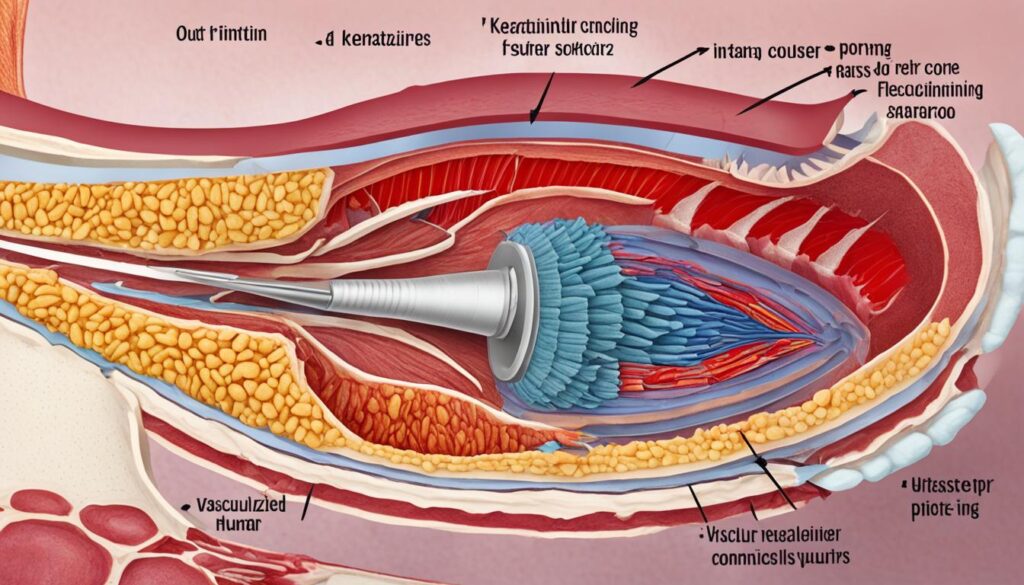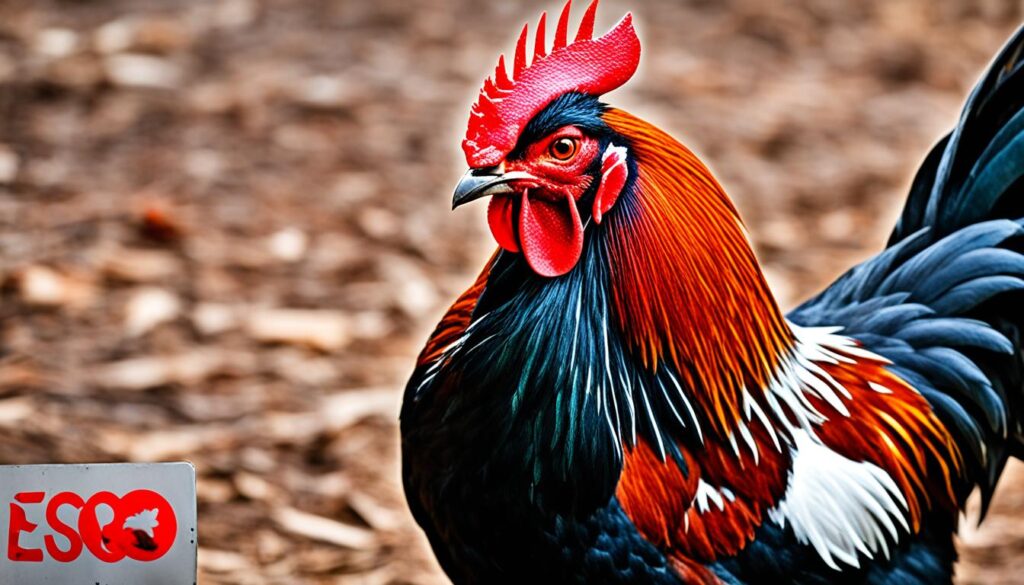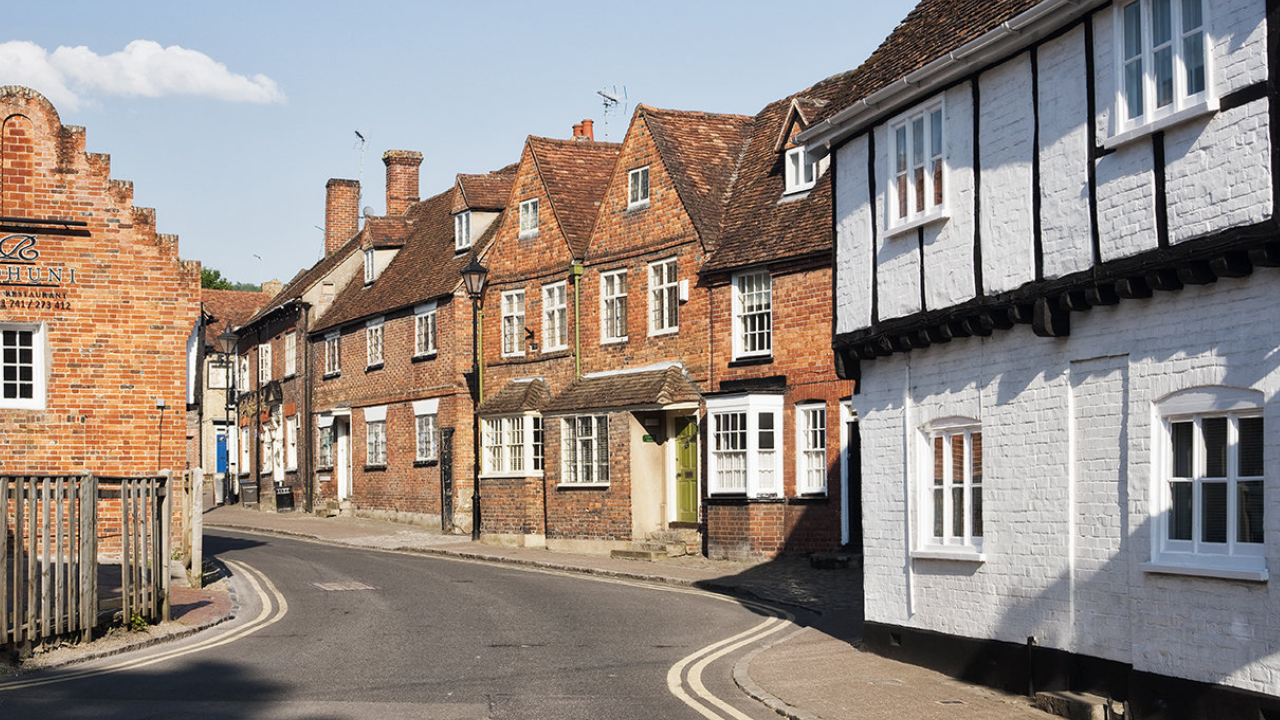Roosters are interesting birds, but they can be dangerous because of their sharp spurs. It’s important to know how to stay safe around them. People often get hurt by rooster spurs, so it’s good to understand how to prevent and treat these injuries.
If you own pets, work on a farm, or love poultry, knowing the risks is key. Taking steps to prevent rooster attacks can help avoid getting hurt. By following the advice given, you can safely be around your roosters.
Understanding Rooster Spurs
Rooster spurs are fascinating parts of a rooster’s life. They play a big role in how he lives and interacts with others. By learning about rooster spurs, we see their importance in chicken biology.
What are Rooster Spurs?
Rooster spurs are bony growths on a rooster’s legs. They are covered with a keratin sheath, the same stuff that makes up human nails and hair. These spurs are crucial and start forming early in a rooster’s life. They show how these parts are key to the bird’s life.

Why Roosters Have Spurs
Rooster spurs serve many purposes, like defense and dominance. In the wild and at home, they help roosters set social order and keep the flock safe. They also play a part in mating and fighting over territory. Experts say these spurs are nature’s way of protecting the birds and letting them show who’s boss.
Common Causes of Rooster Spur Injury to Human
It’s important to know why rooster spur injuries happen. We’ll look at three main reasons: rooster aggression, accidental spur contact, and bad handling. These are key to preventing injuries and handling poultry safely.
Aggressive Behavior in Roosters
Roosters can be aggressive due to territory, mating, and flock dynamics. This aggression can lead to spur use. It’s key to spot early signs of agitation and manage the flock well.
Accidental Contact with Spurs
Accidents with rooster spurs can be serious. They often happen when handling roosters or in tight spaces. To avoid these, keep areas safe and watch where roosters are.
Inadequate Handling Techniques
Bad handling methods lead to injuries. If roosters are not handled right, they might get aggressive. Using the right methods can lower injury risks and make things safer.

| Cause | Description | Preventive Measures |
|---|---|---|
| Rooster Aggression | Triggered by territorial and mating behaviors. | Recognize signs of agitation, manage flock environment. |
| Accidental Contact | Unintentional encounters often during handling. | Maintain organized space, be aware of rooster positions. |
| Inadequate Handling Techniques | Improper methods increase risk of injuries. | Learn and adopt correct handling techniques. |
Symptoms of Rooster Spur Injury
It’s crucial to spot rooster spur wounds early for the best treatment and to avoid more problems. This part will cover the visible signs and health issues that can come from these injuries.
Visible Signs of Injury
Rooster spur injuries show in different ways. Look out for these common signs:
- Lacerations: These are cuts or tears in the skin that might be bleeding.
- Puncture Wounds: Deep, narrow wounds which could be minor or severe based on their depth.
- Swelling and Redness: Typically, a sign of body’s inflammatory response to the injury.
Cleaning and watching these wounds closely can stop infections from happening.
Potential Health Complications
Rooster spurs can cause more than just surface wounds. If ignored, these injuries can turn into bigger problems:
- Infections: Without proper care, a puncture can easily become infected.
- Allergic Reactions: Some individuals may develop severe reactions to the proteins in rooster saliva or feathers.
- Sepsis: A potentially life-threatening condition resulting from an untreated infection spreading through the bloodstream.
Knowing the risks from rooster attacks helps us act fast and right, cutting down on long-term health problems.
First Aid for Rooster Spur Injuries
Rooster spur injuries can look scary but are often minor. It’s key to act fast and right to treat them and avoid problems. Here’s a simple guide to help you take care of these injuries well.
Immediate Steps to Take
When a rooster spur injury happens, here’s what to do first:
- Clean the Wound: Rinse it with clean water to remove dirt or debris.
- Disinfect: Use an antiseptic to stop infection.
- Apply Pressure: If it’s bleeding, press it with a clean cloth or bandage.
- Bandage: Put a sterile bandage over it to protect it.
Having a first aid kit for poultry can help you treat rooster spur wounds better. Make sure your kit has antiseptics, bandages, and gloves.
When to Seek Medical Attention
Not every rooster spur injury needs a doctor. But, there are times you should get help fast:
- Deep Wounds: If it’s deep or won’t stop bleeding with pressure.
- Infection Signs: Look out for redness, swelling, or pus around the injury.
- Tetanus Risk: If you haven’t had a tetanus shot in 10 years.
| Severity of Injury | Recommended Action |
|---|---|
| Minor Scratches | Clean and bandage at home |
| Moderate Cuts | Disinfect, apply pressure, and bandage |
| Severe Lacerations | Seek immediate medical response to rooster attacks |
Right first aid for poultry injuries can stop more problems. Watch the wound for signs of infection. And, follow up with doctors as needed.
Preventing Rooster Spur Injuries
Managing rooster behavior is key to avoiding injuries from their spurs. By knowing their nature, you can lower the chance of aggression. Here are some ways to reduce aggression and keep everyone safe:
Start with rooster behavior management techniques. Teach roosters to be friendly with humans early on. This can greatly reduce their aggression. Regular handling and socializing can also help lower their fear and aggression towards people.
Changing the environment is also important for reducing poultry aggression. Give roosters enough space in their coop and outside. This helps prevent fights over territory. Adding places to hide and climb can also help them avoid conflicts, making things calmer.
It’s crucial to take steps for rooster spur safety too. Trimming the roosters’ spurs keeps them from getting too sharp. Wearing gloves and long sleeves can protect handlers from injuries. Teaching everyone how to handle the birds safely can also reduce the risk of getting hurt.
| Techniques | Benefits |
|---|---|
| Rooster Behavior Management | Reduces fear and aggression |
| Environmental Modifications | Minimizes territorial disputes and stress |
| Rooster Spur Safety Measures | Prevents dangerous spur overgrowth |
Using these methods can make a safer, more peaceful place for roosters and their owners. These practices come from experienced farmers and research. They help keep the birds safe and the people handling them safe too.
Best Practices for Safe Poultry Handling
Handling roosters and other poultry safely is key for everyone’s well-being. This guide shares top tips for safe chicken handling. It covers effective rooster training and keeping poultry farms safe.
Training and Socializing Roosters
Start training young roosters early. Handle them gently and let them get used to people. This builds trust and cuts down on aggression. Reward them with treats to make them friendlier and easier to manage.
Using Protective Gear
Protective gear is a must for poultry safety. Wear thick gloves, long sleeves, and eye protection when you’re around roosters. This gear protects you from their sharp spurs and sudden pecks.
Creating a Safe Environment
It’s not just about how you handle them; it’s also about their living space. Make sure their homes are big and stress-free. This helps them stay calm and reduces aggression. Always check their living areas for dangers that might upset them, keeping your farm safe.
Conclusion
Understanding rooster spurs and their dangers is key for poultry farmers. This article covered how to handle roosters safely and prevent injuries. It showed the importance of being aware and using the right techniques.
We talked about what to do if a rooster spur gets injured. It’s vital to act fast and right to avoid more problems. Using training, protective gear, and a safe space is crucial for a safe rooster community.
The secret to getting along with roosters is knowledge, preparation, and respect for their nature. Success stories from farmers show that with effort and care, we can have a safe place for both people and roosters.
FAQ
What are rooster spurs?
Rooster spurs are hard growths on a rooster’s leg. They help protect and show who’s in charge.
Why do roosters have spurs?
Roosters have spurs to stay safe and be the top bird in their group. These parts help them act and interact with others.
How can aggressive behavior in roosters cause injuries?
When roosters fight, their spurs can hurt others. This happens over things like land, mates, and group order.
What are the common signs of a rooster spur injury?
Look for cuts, holes, redness, and swelling if a rooster gets hurt. Sometimes, infections can happen too.
What immediate steps should be taken for a rooster spur injury?
Clean the wound with soap and water right away. Use an antiseptic and cover it with a clean bandage. Get help if it looks bad.
How can rooster spur injuries be prevented?
Stop rooster fights with training and safe gear. Make a safe place for roosters and people.
What is the best way to handle a rooster safely?
Make sure the rooster is friendly and well-trained early on. Use safe handling methods and protective gear.
When should I seek medical attention for a rooster spur injury?
Get help if the cut is deep, won’t stop bleeding, looks infected, or hurts a lot. If it’s very swollen, too.
What protective gear is recommended when handling roosters?
Use strong gloves, long sleeves, and tough boots to protect against rooster spur injuries.
Are there any legal regulations regarding rooster handling on farms?
Yes, farms must follow safety rules and advice from experts to handle roosters safely.







